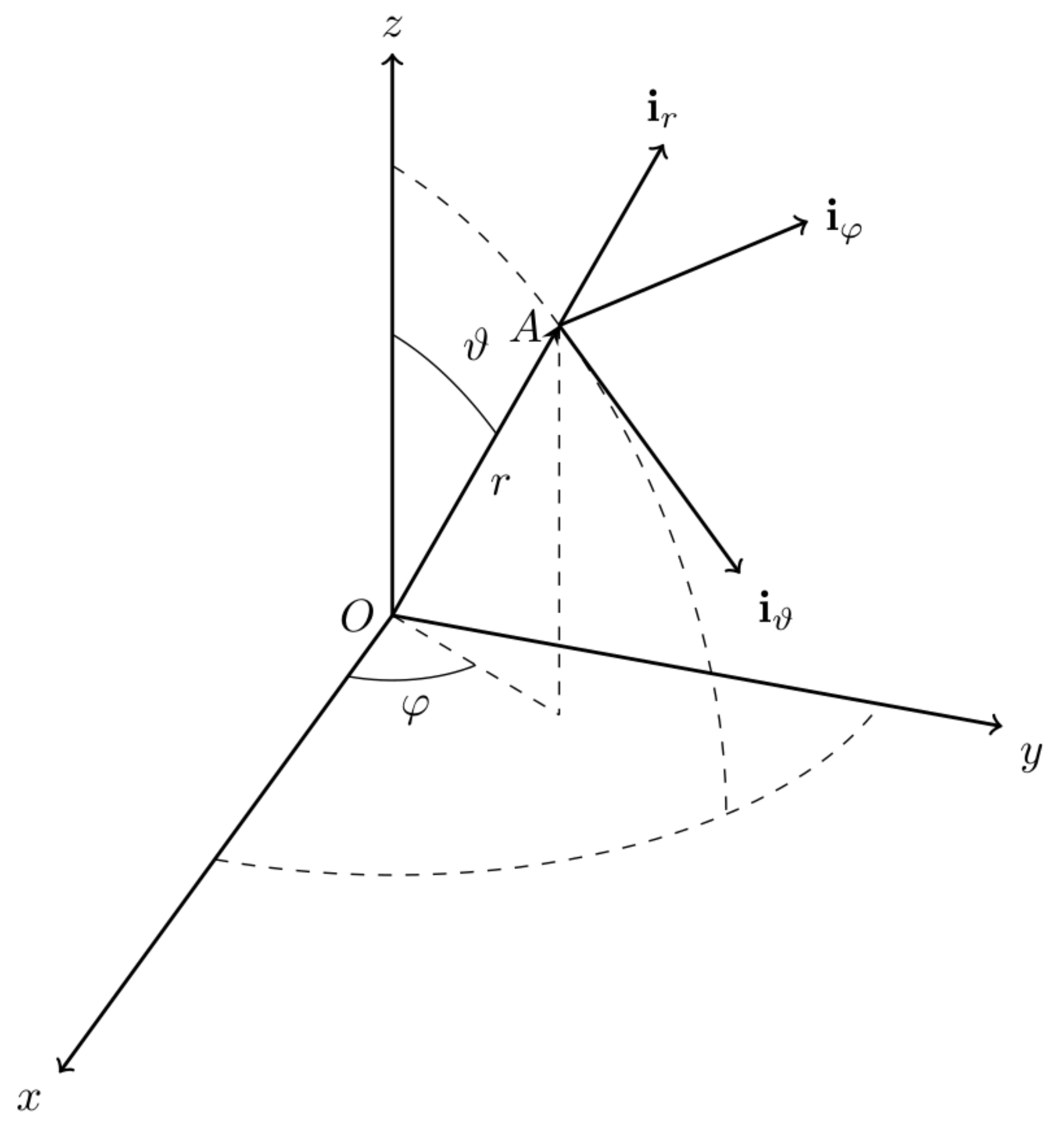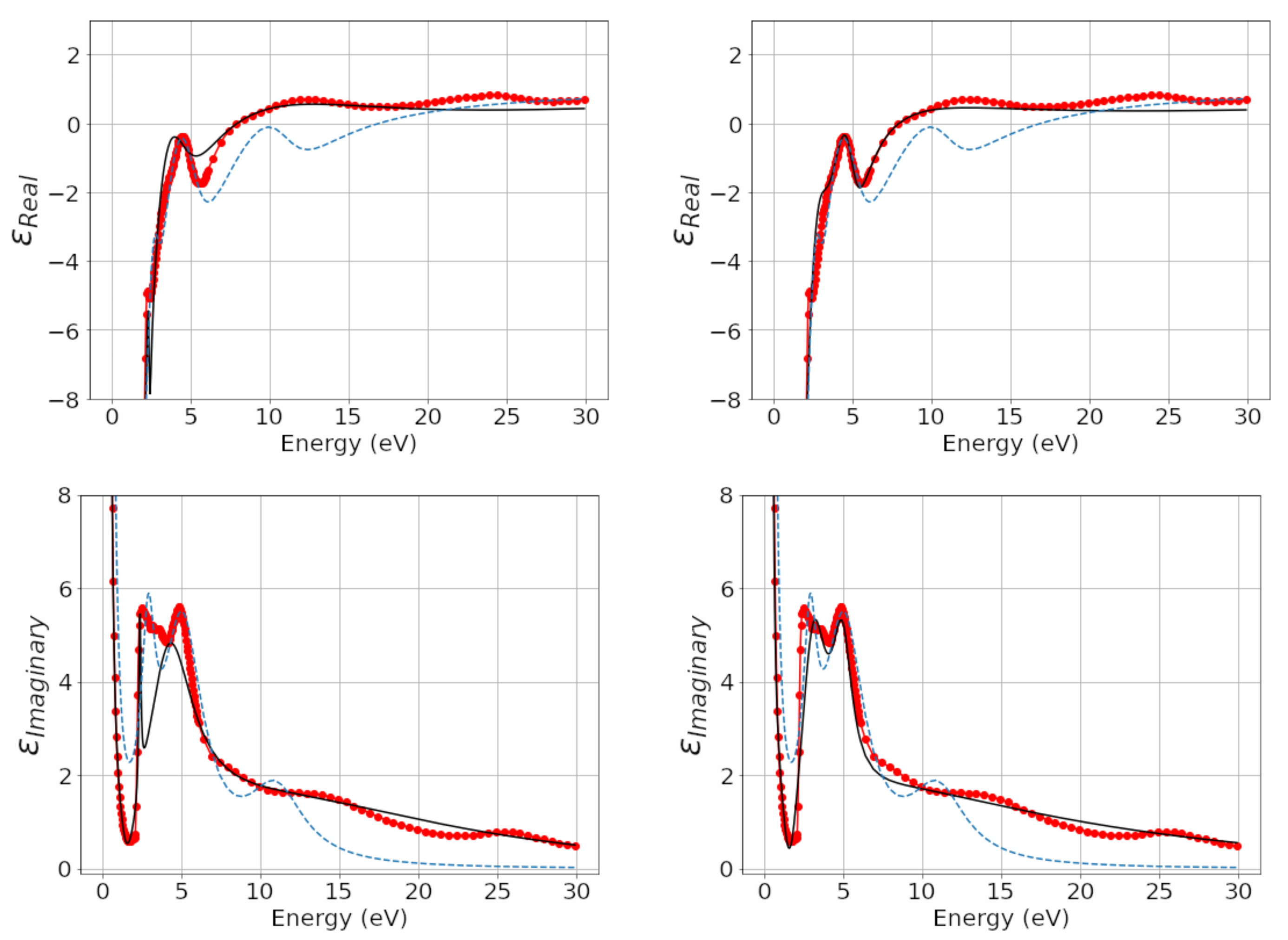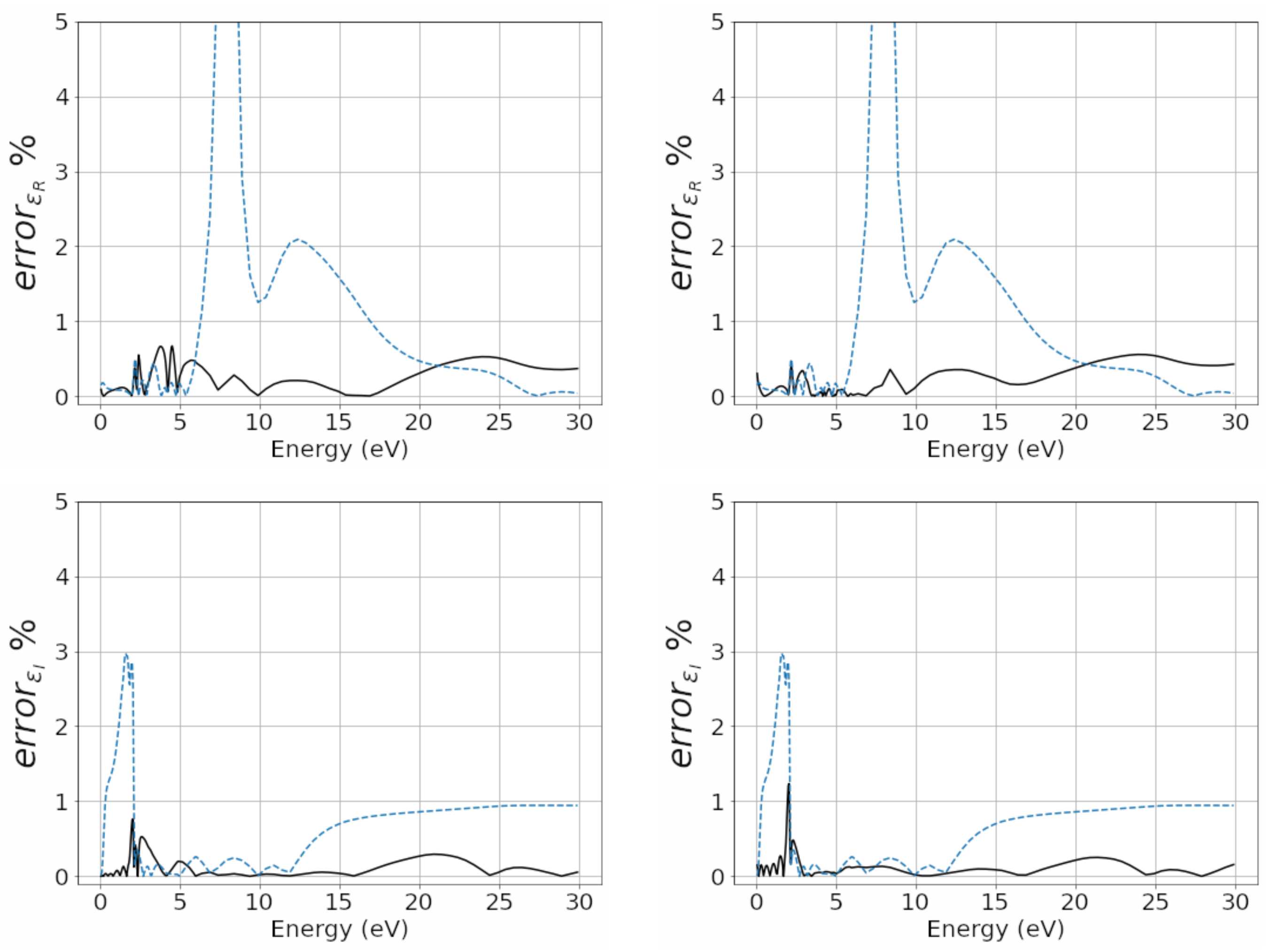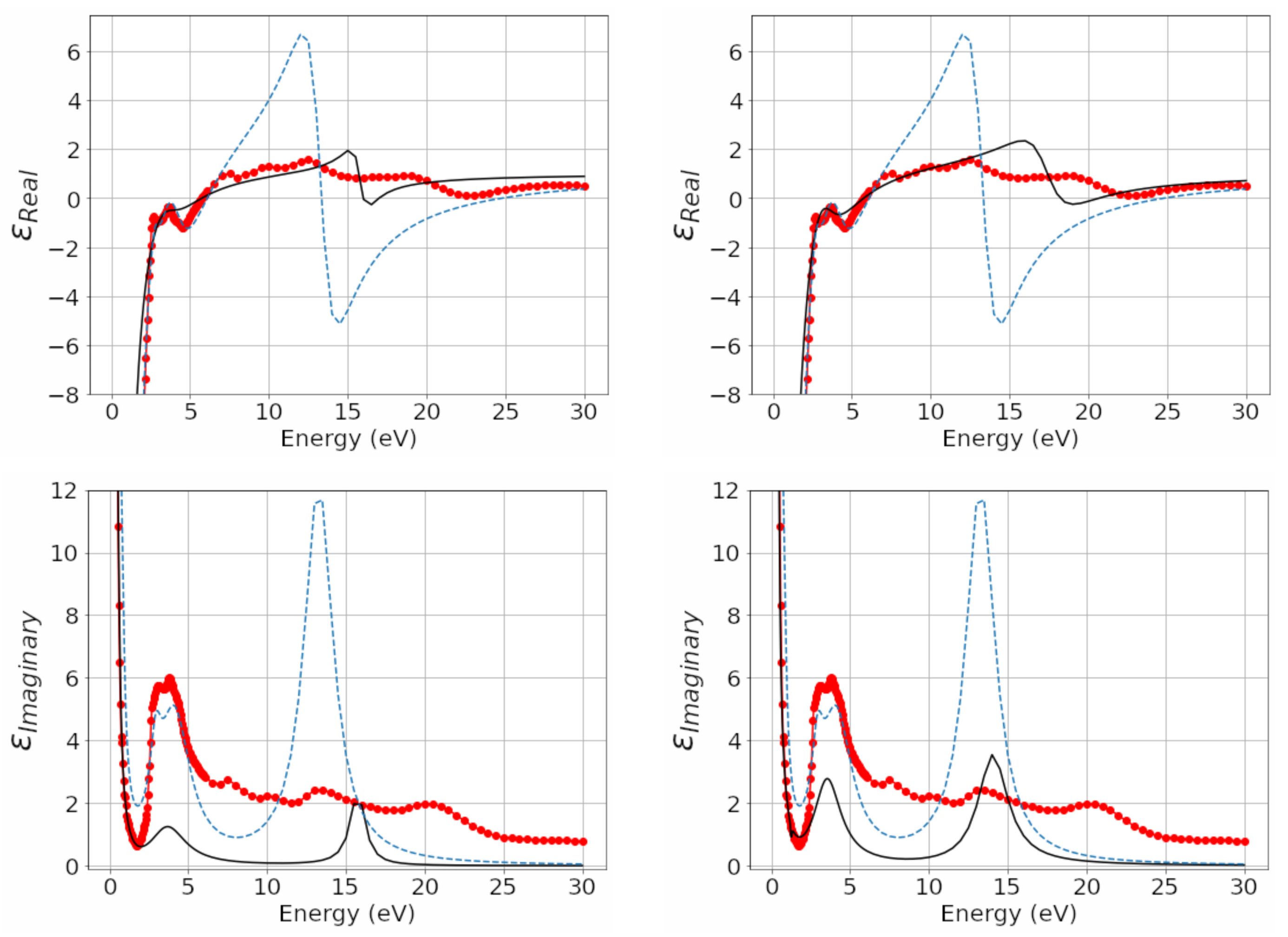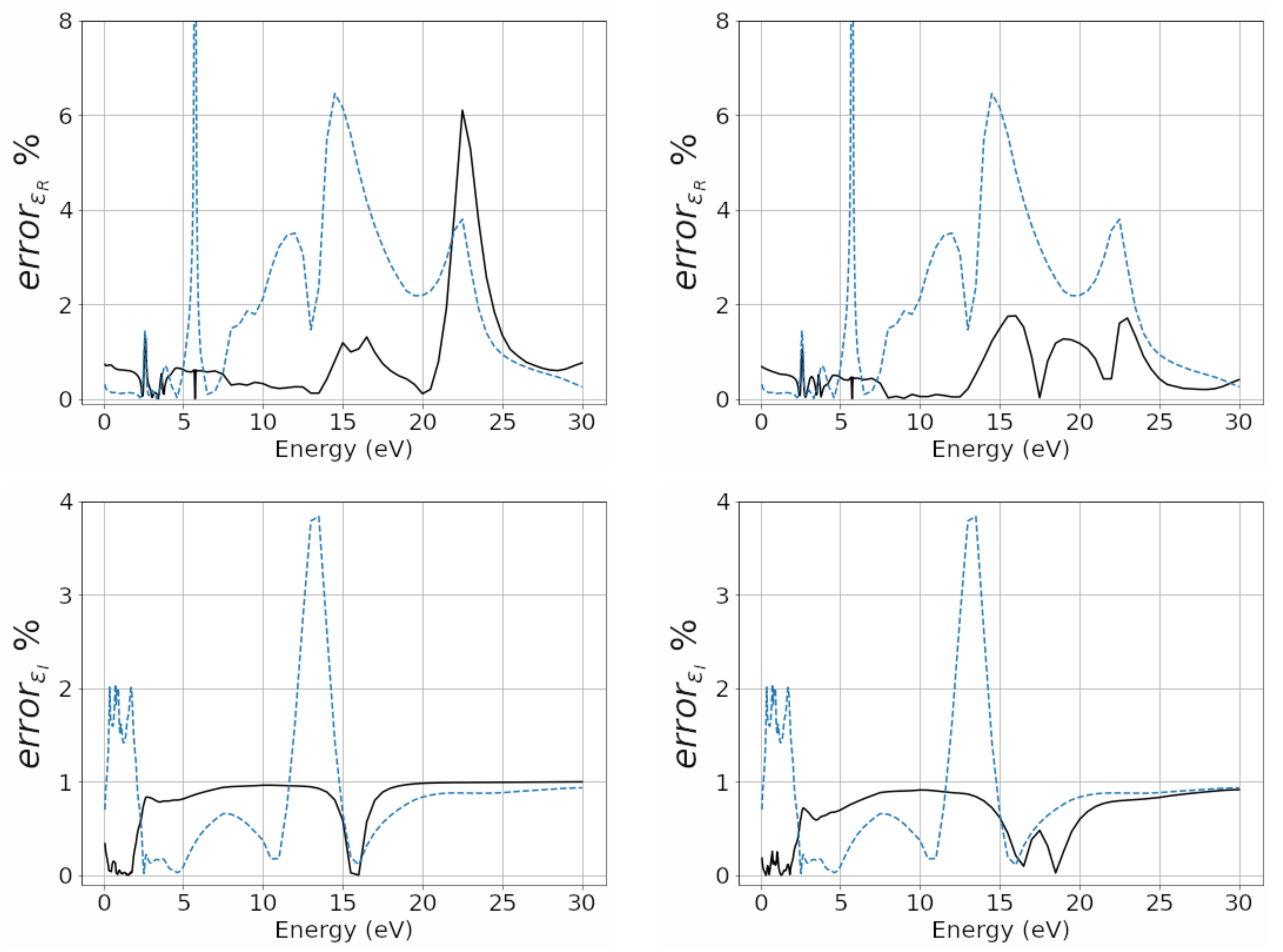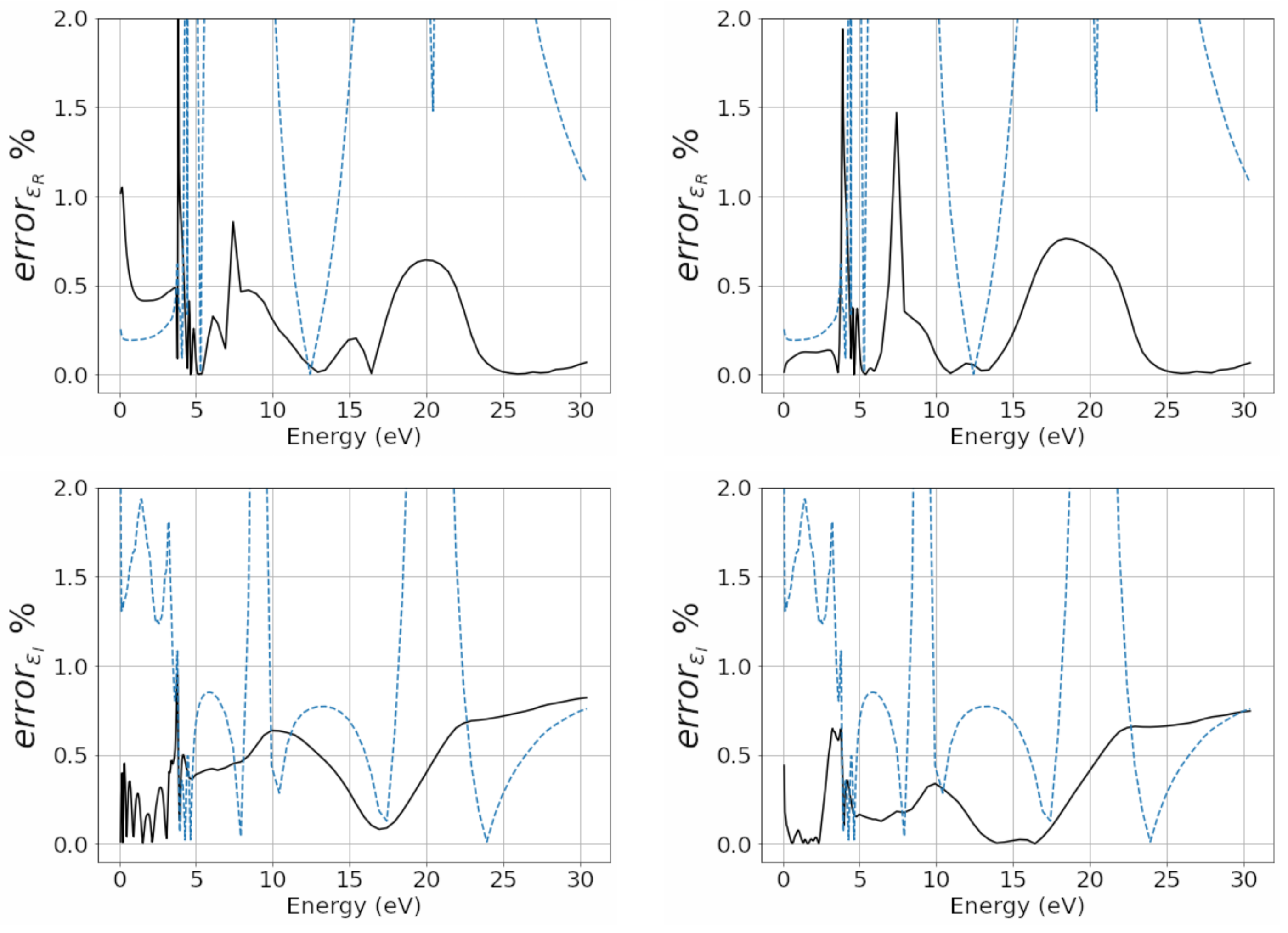1. Introduction
The electromagnetic behavior of materials is characterized by the electric and magnetic permittivities. The actual mechanisms that determine this behavior are due to the action of the forces that interact on the system resulting in dissipative phenomena involving a large number of microscopic units and a nontrivial dynamics of entropy production. As such, these phenomena can be usefully described by non-equilibrium thermodynamics (NET). In particular, the theoretical apparatus proposed by De Groot and Mazur [
1,
2] is of particular interest when investigating dynamic irreversible phenomena. Remarkably, they introduced the concept of internal variables. to model internal dissipative phenomena at a macroscopic scale. In the framework of the NET [
1,
2,
3], by extending the works [
4,
5,
6,
7,
8,
9], Ciancio and Flora [
10] proposed a fractional model of dielectric permittivity that is more general than the key models of the literature.
As far as metals [
11] are concerned, existing fractional models such as [
12], although providing useful insights, are limited by a short range of wavelengths and do not focus on energy adsorption and scattering.
Given the above-illustrated framework, here we introduce a new fractional model of relaxation for conductors. Our aim is to show that this new approach is able to perform better than previous models inferred from quantum mechanics, such as [
13]. Moreover, this improvement is obtained both in a larger number of material and in larger ranges of energies. We also aim at (i) improving the inference of the surface plasmonic waves; (ii) improving the inference of the scattered fields by conductors. This work is organized as follows: in
Section 2, we summarize relevant research of interest; in
Section 3, we infer the fractional substantial derivative, which we later utilize; in
Section 4, we extend the fractional dielectric model of [
10]; in
Section 5, we apply our framework to plasmonic materials with relaxation; in
Section 6, we propose a new model for media conductors, which employs classical derivatives; in
Section 7, we propose a fractional model for conductors; in
Section 8, we show our result and comparisons with other models. This work is ended by general conclusions, illustrated in
Section 9.
3. Inference of the Fractional Substantial Derivative
In this section, we infer the fractional substantial derivative. This is a mathematical tool that is useful for the determination of the distribution of vector fields in a fractional space. We employ it in order to obtain an analytical formula for the computation of the complex permittivity.
In the unidimensional case, the substantial derivative of a (scalar or vectorial) field reads as follows:
There are many definitions of fractional derivative [
18] (see
Appendix A). We adopted the Caputo derivative, since we believe that it well suits the problems related to high-frequency electromagnetic fields. Indeed, the Caputo fractional derivative has a kernel particularly fit to describe the surface propagation of polarons; a second and important reason: the Caputo fractional derivative [
19] is particularly fit to describe phenomena with memory [
20]. Fractional derivatives based on non-singular kernels would not be appropriate. Apart from the above-mentioned reasons, we think (and results seems to agree with our vision) that the use of the Caputo derivative in the model allows a better phenomenological of the behavior of plasmonic media. In particular, the association to the inter-band interplay electron–electron, electron–phonon and in the surface scattering can be easily described without recurring to a full quantum description. Thus, the use of a fractional approach allowed us to better fit experimental data. In the framework of Caputo fractional calculus [
19], the partial derivatives of a field reads as follows
where
is an order non-integer of the fractional derivative,
is Euler Gamma function,
is the fractional temporal kernel and
is the fractional spatial kernel. Spherical coordinates are useful from a computational point of view, for example, to determine the differential equation of the scalar potential that solves the problem of the field absorbed and scattered by a spherical particle of metal [
21]. In this section, we report a new expression of substantial derivative that depends on the metric of fractional space and on the position of a material point with respect to a system of spherical coordinates.
Let us consider a plane wave propagating in an isotropic space. In this case, the fractional order depends only on the propagation direction found by the unitary vector . It is shown that if then the substantial fractional derivative coincides with the partial derivative relative to time.
3.1. Distance of a Material Point from the Origin
The concept of metric intervenes in geometry whenever it becomes necessary to measure certain geometric entities that belong to a given space. For example, the distance of a point from the origin, the area of a surface, etc... In a fractional space, we calculate the distance of an object placed in point
A from the origin of a reference system in spherical coordinates,
Figure 1, by means the fractional integral of Caputo.
The Caputo integral of a
function is given by:
Using spherical coordinates, the distance of a point in the position
r with respect to the origin is given by:
The integral is immediate (
17). Setting:
we have:
therefore the (
17) becomes:
i.e.,
representing the distance, in fractional space, of point P in the position
r with respect to the origin of a reference system in spherical coordinates [
22]. If
we observe:
, with
, then:
.
3.2. The Substantial Fractional Derivative of Caputo
From the definition of a substantial ordinary derivative of a vector function
:
The fractional derivative of Caputo is:
Applying the equation to the expression of the ordinary substantive derivative, replacing the ’classical’ partial derivative with the partial fractional derivative and taking into account the metric yields:
where the fractional partial derivatives with respect to
t and
s are given, respectively, from (
15) and (
16), with:
From the (
21) and (
15), (
16) and (
22), the substantial fractional derivative is:
In the particular case where
, we have:
i.e.,:
Finally, if
the substantial fractional derivative coincides with the partial fractional derivative respect to
t, expressed by the (
15). In the case of
, the complete Laplace transform of the (
24) is:
6. A New Ordinary Derivatives-Based Model for Conductors
Thanks to the new concepts introduced in
Section 5, we are able now to develop a new model applicable to conductors and based on classical derivatives.
Transforming both members of the (
41) with respect to time, since the
field moves away from the conductor, we have:
Applying Fourier transform to Equation (
6) yields:
from the comparison of (
42) with the (
43) we obtain the ordinary Ciancio–Kluitenberg model that represents the complex relative permittivity of the conductive media:
If we impose:
then we obtain the Abraham–Lorentz model [
26]
where
is damping factor,
is plasmon pulsation,
is pulsation of the natural oscillation,
is mass of the electron and
is the damping factor component due to the radiation reaction, which depends on the square of the angular pulsation. This formulation has previously been derived, in another way, by using the concept of radiation reaction force, which contradicts Newton’s third principle as discussed in [
16]. The theory of NET overcomes this contradiction.
If the coefficient
, i.e., the radiation reaction is not considered, the Drude–Lorentz model is obtained:
that is, for the first three relations of the (
45):
which represents the Drude–Lorentz model in the form obtained by another way in [
17]. If the natural oscillation pulsation (
) is negligible, we obtain the Drude model.
7. A Fractional Conductor Model
Here we change paradigm by employing fractional derivatives in our model.
Considering the fractional differential equation corresponding to the (
41), substituting the ordinary derivative for the fractional one, we obtain the fractional relaxation equation for plasmonic materials:
Applying the properties of the Laplace transform and keeping in mind that the
field moves away from the conductor, we immediately obtain the Ciancio–Kluitenberg’s fractional model expression of the relative complex permittivity to the media perfectly conductive:
The electromagnetic behavior of conductors depends on quantum phenomena and atomic interactions, such as those between electron–electron and electron–phonon, whose description is very complex. Applying the theory of the joint density of states, the resulting models has more than 30 variable parameters, whose determination is difficult and laborious (see [
13]). An alternative semi-quantum theory, describing the behavior of conductor materials, has been formulated in [
27,
28].
The fractional order of the derivative allows to determine the values of algebraic functions that, within the fixed limits of the considered interval and taking into account the increase in entropy, gives a good approximation of the relative complex permittivity. To describe phenomena that occur on electronic scale (from
Hz) the system must be represented by a system of
m fractional relaxation equations, where
m depends on the material. The first Equation (
51) describes intra-band interaction while the remaining
equations describe inter-band transitions:
Applying the Fourier transform to the above equations, we easily obtain the complex relative permittivity:
where:
where
is the pulsation of the natural oscillation. Note that the phenomenological coefficients associated with the state variables represent the physical quantities of a system consisting of oscillators characterized by their own elastic mass proportional to the plasmon pulsation
of the material, from a damping factor
and a resonant frequency
, with
. The damping factor,
, depends on electron–electron, electron–phonon and surface scattering:
where
K is the room temperature. Taking:
the term
may be seen as the square of an effective plasmonic angular frequency
:
where
volumetric expansion coefficient of the metal that for gold is equal to
.
The intra-band damping factor,
, is given by:
where:
for gold (Au):
;
;
[eV];
, where
is Fermi’s level.
for Au:
[eV];
[K]
with:
. The DL model is obtained by canceling the damping factor due to the Abraham–Lorentz force:
8. Results
In this section, we validate our model. Namely, here we report the results of our simulations related to the fractional models of Drude–Lorentz and Abraham–Lorentz and we compare them with the ordinary model of Drude–Lorentz obtained by Rakic [
29]. We assume that the parameters vary slowly with temperature.
Table 1 defines the nomenclature of the model parameters:
The proposed Abraham–Lorentz fractional model (
55), considered a system with
equations, is characterized by 30 parameters:
and
, since:
The Drude–Lorentz fractional model, considering a system with
equations, is characterized by 24 parameters:
and
, having neglected the six parameters
and being:
The parameters of the fractional models were obtained by fitting the experimental measurements of permittivity reported in [
30]. To fit these data, we used the differential evolution algorithm (DE) [
31,
32,
33]. The DE algorithm is an iterative method of stochastic nature for the search of the possible global optimal solutions on large space of parameters. We implemented the fitting procedure by using the Python language and its scientific library
scipy [
34]. We have chosen the DE algorithms because of its ability to provide trustable global minima, at variance of classical deterministic optimization algorithms (such as the gradient method or Newton’s method) that are prone to stuck to local minima. Moreover, many of the deterministic algorithms additionally require to provide the derivative of the objective function. In [
29,
35] the SA (simulation annealing) algorithm has been used, which requires many experimental values in contrast to the DE. To compare results, unlike the original target function used:
in this work the target functions used are:
and
where
M is the number of experimental values related to the real part,
, and imaginary
of the complex permittivity in function of the angular frequency
(energy units: Electron volt). In particular, the following metals are considered: Cu, Ag and Au [
30]. With reference to the experimental data on Cu, applying the DE algorithm and using the objective function given by Equation (
66), in
Table 2 and
Table 3, the values of the parameters of the fractional model DL and AL are given. For the model DL, you have a
eV , whereas for model AL you have a
eV. We observe that the fractional order of the relaxation equation describing the intra-band component, represented by the Drude model, and the fractional orders of the relaxation equations related to the inter-band component clearly deviate from the unit. In the left panels of
Figure 2, the trends of the real and imaginary part of the complex permittivity, of the DL models, of Rakic and of the measurements obtained by Weaver are compared; in the left panels of the same figure, we compare the trends of the real and imaginary part of complex permittivity, models of AL, Rakic and measurements obtained by Weaver. One can observe how the AL model is better than the DL model. In
Figure 3, the relative complex permittivity errors in percent, compared to the corresponding experimental values, are reported in the left panels (upper panel the real part and lower panel the imaginary part) of the fractional models DL and Rakic; in the right panels of the same figure (upper panel the real part and lower panel the imaginary part), we report those of the models AL and Rakic. It can be observed that the trend of the relative percentage error of the DL fractional model is 1% lower for both the real and the imaginary part. The real part of the relative percentage error of the Rakic model is greater than 1% and around
eV is more than 50%.
With reference to the experimental data on Au, applying the DE algorithm and using the objective function given by Equation (
66), in
Table 4 and
Table 5, the values of the parameters of the fractional model DL and AL are given. For model DL, it yields
eV, whereas for model AL you have a
eV. It is observed how the fractional order of the relaxation equation described the intraband component, represented by the Drude model, and the fractional orders of the relaxation equations related to the interband component clearly deviate from the unit. In the left panels of
Figure 4, we compare the the real and imaginary part trends of the complex permittivity, of the DL models by Rakic and the measurements obtained by Weaver; in the left panels of the same details are compared of the real and imaginary part trends of complex permittivity; the models of AL, Rakic and measurements obtained by Weaver. One can observe how the AL model is better than the DL model. In
Figure 5, the relative complex permittivity errors in percent, compared to the corresponding experimental values, are reported in the left panels (upper panel the real part and lower panel the imaginary part) of the fractional models DL and Rakic; in the right panels of the same figure (upper panel the real part and lower panel the imaginary part) we report those of the models AL and Rakic. It can be observed that the trend of the relative percentage error of the DL fractional model is 1% lower for both the real and the imaginary part. The real part of the relative percentage error of the Rakic model is greater than 1% and around 6 eV is more than 50%.
With reference to the experimental silver data, applying the DE algorithm and using the objective function given by Equation (
66), in
Table 6 and
Table 7, the values of the parameters of the fractional model DL and AL are given. For model DL, you have a
eV, whereas for model AL, you have a
eV. It is observed how the fractional order of the relaxation equation describing the intraband component, represented by the Drude model, and the fractional orders of the relaxation equations related to the interband component, clearly deviate from the unit. In the left panels of
Figure 6 of the real and imaginary part trends of the complex permittivity, the DL models, Rakic and the measurements obtained by Weaver are compared; in the left panels of the same figure we compare the real and imaginary part trends of complex permittivity, models of AL, Rakic and measurements obtained by Weaver. One can observe how the AL model is better than the DL model. In
Figure 7, the relative complex permittivity errors in percent, compared to the corresponding experimental values, are reported in the left panels (upper panel the real part and lower panel the imaginary part) of the fractional models DL and Rakic; in the right panels of the same figure (upper panel the real part and lower panel the imaginary part), we report those of the models AL and Rakic. It can be observed that the trend of the relative percentage error of the DL fractional model is 1% lower for both the real and the imaginary part. The real part of the relative percentage error of the Rakic model is greater than 1% and around
eV, 17 eV and
eV is more than 50%.
Overall, the fractional models (CK-F) of Drude–Lorentz (DL) and Abraham–Lorentz (AL) are similar in energy values from tenths of electron volts to a few electron volt units, with a better fitting of the AL model than the DL model. For low energy values, the Rakic model condenses experimental data in a similar way to fractional models. For energy values of more than 5 eV, the Rakic model deviates from the experimental values both for the real part of permittivity, and the imaginary part, . As for the fractional models, there is a better approximation of the AL model for the real part of permittivity than the DL model, whereas for the imaginary part, the fitting deviates from the experimental values without ever exceeding 2%; however, it should be noted that this deviation is justified by the assumption that the temperature at increasing frequency does not vary significantly to change the intra-band damping factor as foreseen in the previous section. The trend of the percentage error of the CK-F model is lower than the Rakic model.
9. Conclusions
Atoms are excited by high-frequency electromagnetic radiation. This results in a non-equilibrium scenario naturally fit to be investigated by the theoretical apparatus of de Groot and Mazur NET. An example in materials with relaxation is the well-known Raman effect (also known as inelastic scattering), which can be described by NET tools, which was one of our aims. Namely, in the first part of this work, we gave a theoretical explanation of the links between the behavior of electromagnetic materials with NET. In particular, we extend the Ciancio–Kluitenberg model [
5] in the framework of fractional calculus. In physics, a material is endowed with
‘memory’ if the output variable (e.g., strain, polarization, etc.) does not only depend on the current physical status but also on previous times. This is mathematically modeled by means of a convolution integral—the Caputo fractional derivative—whose kernel can be read as a pulse response of the system; thus, the fractional exponent can be considered as a measure of the memory of the material. For dielectrics, this index is in the interval (0,1). In metals, the Caputo fractional derivative represents a larger sensitivity to large frequencies (or, equivalently, energies). In particular, we think that the intra- and inter-band transition at very high frequencies determine the above-mentioned memory effect. Our model represents these complex phenomena via a phenomenological model where multiple components (each with a distinct memory index) are taken into the account.
After building the above-mentioned theoretical model, we also validated it, and showed that our approach can be considered as an improvement of previous studies.
Namely, under the hypothesis of quasi-stationarity and superimposability of intra-band and inter-band interaction, the proposed CK-F model is in good agreement with experimental data on a frequency spectrum from infrared to ionizing radiation such as X-rays, i.e., not only in the frequency range typical of mechanical vibrations and for electrically insulating materials but also for plasmonic materials at electronic frequencies. The system consists of a number of subsystems each characterized by a fractional differential equation of relaxation whose overlap is the result of the interaction due to inter-band and intra-band transitions of electrons.
